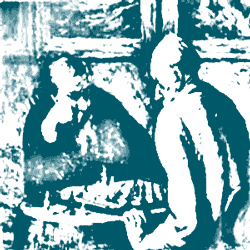Gambit Your Way Through the KPG

The word gambit was first used by Ruy Lopez de Segura in the 16th century. The Italian word gambetto which relates to tripping someone took on the Spanish form gambito. If you want to test your opponent from the very first move this may be the route to go.
We're talking chess openings with a difference. Consider a sacrifice in order to gain an advantage of some sort. Usually when accepted your opponent can with precise play nullify any advantage accrued. However you can often profit against an opponent not familiar with the particular line. You can also talk about your favorites.
These tricks allow you to take your unsuspecting opponents off the beaten track and into unknown territory. You will get a lot of joy taking these guys away from their safe familiar lines. Drag them away from the shore and into deep, dark choppy waters.
These tricks allow you to take your unsuspecting opponents off the beaten track and into unknown territory. You will get a lot of joy taking these guys away from their safe familiar lines. Drag them away from the shore and into deep, dark choppy waters.
We begin with those gems contained in the King's Pawn Game. These openings will start with the moves 1.e4 e5 2.Nf3 Nc6 3.Bc4. Get a flavor of these lines through the Fried Liver Attack, Wilkes-Barre Variation, Evans Gambit and others.
Fry White's Liver in the Two Knights Gambit
































































Two Knights G - 1.e4 e5 2.Nf3 Nc6 3.Bc4 Nf6 4.Ng5 d5 5.exd5 Na5
The Two Knights is the last chance for you to stop White dragging you under the wheels of the Fried Liver Attack. You know that 5...Nxd5 6.Nxf7 Kxf7 7.Qf3 will force you into a very difficult defense to save the game.
This opening activated by 5...Na5 stops all that crazy stuff by driving the Bishop off that dangerous diagonal. 6.Bb5+ c6 7.dxc6 bxc6 leads to an interesting position.
You've given up a pawn, a7 and c6 look like long term weaknesses but it seems like you've alleviated the pressure against your Kingside. White can continue with 8.Be2 or the tactic against your a8-Rook, 8.Qf3.
You've given up a pawn, a7 and c6 look like long term weaknesses but it seems like you've alleviated the pressure against your Kingside. White can continue with 8.Be2 or the tactic against your a8-Rook, 8.Qf3.
Against the first you can harass the White Knight and win time to complete development. Against the second, again moves like 8...Rb8 should win you the time you need to solve your problems.
Fried Liver Attack - Drag the Black King to the Center
































































Fried Liver Attack - 1.e4 e5 2.Nf3 Nc6 3.Bc4 Nf6 4.Ng5 d5 5.exd5 Nxd5 6.Nxf7 Kxf7
The Fried Liver Attack is something you can try out in the Italian Game. Black has a couple of opportunities to avoid it. He can opt for the Giuoco Piano on his third move (3...Bc5). He can also stop it on his fifth move with the Main Line of the Two Knights, 5.Na5. Other interesting ideas are 5...b5 or even 5...Nd4.
If however your opponent is compliant and plays along with 1.e4 e5 2.Nf3 Nc6 3.Bc4 Nf6 4.Ng5 d5 5.exd5 Nxd5 you can get into the Fried Liver Attack with the shocking 6.Nxf7!?
Black is forced to take and 6...Kxf7 7.Qf3 forces 7...Ke6 to hold the d5-Knight. Next comes 8.Nc3 and something like 8...Ncd7 9.0-0 with the threat of 10.Re1 and a second pin against the hapless King.
Counter Attack White with the Dangerous Wilkes-Barre
































































Wilkes-Barre Variation - 1.e4 e5 2.Nf3 Nc6 3.Bc4 Nf6 4.Ng5 Bc5
The Wilkes-Barre Variation is also known as the Traxler Counterattack. Again it's the Italian Game with Black playing the Two Knights Defense. 4.Ng5 comes in as White is playing for the f7 underbelly.
He's hoping to fork Queen and Rook before you can castle. The Fried Liver Attack and other sacrificial ploys on f7 also hang in the air. Of course you can stop such things with the Two Knights G or a combination of 4...d5 and 5...Na5. On the other hand you can simply ignore the threat and launch a counter attack of your own.
The Wilkes-Barre appears with the stunning move 4...Bc5 and after 5.Nxf7 Bxf2+ it is White who must decide whether or not he should take this dangerous gambit and try to weather the storm.
Steal Moves in the Evans Gambit
































































Evans G - 1.e4 e5 2.Nf3 Nc6 3.Bc4 Bc5 4.b4
The Evans saw it's heyday at the top table of chess during the Romantic Era in the 19th Century. It fits in perfectly with the flavor of the day. 4.b4 suddenly injects life into the quiet Italian Game.
Your idea is to give up this b-pawn and in return gain a couple of tempi. This will give you a big lead in development and a good initiative. You will castle soon and have more pieces in play than Black. You will also enjoy a space advantage.
Chess evolved into positional science and the Evans, along with many other Romantic opening systems, fell into disuse. It never went into extinction though. GMs still use it sparingly. It has remained popular at beginner and intermediate level where you can enjoy great success with it.
Fight Fire with Fire in the Evans Countergambit
































































Evans Countergambit - 1.e4 e5 2.Nf3 Nc6 3.Bc4 Bc5 4.b4 d5
The Evans Countergambit is probably the most violent answer to the Evans G. The usual responses to the Evans are the main Accepted Lines, 4...Nxb4 and 4...Bxb4 and the main Declined Lines, 4...Ba5 and 4...Bc5.
What if you're not excited about passively ceding territory in the Declined Lines? You don't find the Accepted Lines sharp enough for your tastes? There is another way.
Answer the threat with a counter-threat. 4...d5. Does White know his Evans theory as well as he ought to? What happens if he goes down the 5.bxc5 dxc4 road? Who has the edge then? What possibilities and threats lurk in this position?
Italian Gambit - Break Through the Center
































































Italian G - 1.e4 e5 2.Nf3 Nc6 3.Bc4 Bc5 4.d4
The Italian proves that the Italian Game is not necessarily a quiet opening. 4.d4 prior to castling shows that White is ready for a fight. You want to break open the center. Your goal is to force huge concessions from Black just to stay in the game.
Black can respond with 4...Bb6, 4...Nxd4 or 4...exd4. All of these moves have their drawbacks allowing you to gain a decisive advantage.
Black's best response is 4...Bxd4. This prevents you from pushing on with e5 in a Max Lange style offensive bursting through the center. You can still pose dangerous threats as you mount your attacks on the Kingside.
Build Rapid Attacks in the Jerome Gambit
































































Jerome G - 1.e4 e5 2.Nf3 Nc6 3.Bc4 Bc5 4.Bxf7+ Kxf7
The Jerome is also available to White in the Italian Game. It's another play on Black's weak f7-pawn. After 1.e4 e5 2.Nf3 Nc6 3.Bc4 Bc5 4.Bxf7+ Kxf7 you have given up your powerful light square Bishop but not for nothing.
You have a lead in development and crucially the Black King is trapped in an open looking center. He will also be a hindrance to the activity, connectivity and harmony of his own pieces.
Now you go forward on the Kingside in the traditional manner; short castle, Queen patrolling the d1-h5 diagonal, Knight waiting to hop into e5 or g5 and so on.
Central Liquidations of the Boden-Kieseritzky Gambit
































































Boden-Kieseritzky G - 1.e4 e5 2.Nf3 Nc6 3.Bc4 Nf6 4.Nc3 Nxe4 5.O-O
The Boden-Kieseritzky is another way to try and break the solid Two Knights Defense. Rejecting continuations like 5.Nxe4 d5 6.Bd3 dxe4 7.Bxe4 or 5.Bxf7 Kxf7 6.Nxe4, you can simply castle.
After 5.0-0 the Main Line goes Nxc3 6.dxc3 Be7 7.Qd5 0-0 8.Nxe5 Nxe5 9.Qxe5 Bf6 and the position has simplified a little. You've got your pawn back and but you have doubled pawns. You still retain a lead in development albeit slight. This position is fine for both sides.
It's also possible to reach the Boden-Kieseritzky via the Bishop's Opening, this is a different move order. Some people don't even include the Queenside Knights in this gambit's starting position. They call for example 1.e4 e5 2.Bc4 Nf6 3.Nf3 a Boden-Kieseritzky. You can also transpose to this opening from the Petroff Defense via the moves 1.e4 e5 2.Nf3 Nf6 3.Bc4 Nxe4 4.Nc3 Nxc3 5.dxc3 f6.
Hustle in the Club with the Blackburne-Shilling Gambit
































































Blackburne-Shilling Gambit - 1.e4 e5 2.Nf3 Nc6 3.Bc4 Nd4
The Blackburne-Shilling is a nice little trick you can play as Black in the Italian Game. Usually after 3.Bc4 Black will respond with a routine move like 3...Bc5 or 3...Nf6.
If you have Black you will be happy to hear that in this position you can roll the dice. Now you can throw in the surprising move 3...Nd4, apparently self-destructing.
If you have Black you will be happy to hear that in this position you can roll the dice. Now you can throw in the surprising move 3...Nd4, apparently self-destructing.
White can get an advantage with theoretical knowledge and correct play. As usual though, without this knowledge the correct move is not always easy to find.
White should of course continue by exchanging Knights with a good game to come. Taking the pawn however and threatening f7 may prove to juicy to turn down.
White should of course continue by exchanging Knights with a good game to come. Taking the pawn however and threatening f7 may prove to juicy to turn down.
It's in this position that Black can spring his plan into action. 4...Qg4 (forking the e5-Knight and g2-pawn) 5.Nf7 (trapping the h-Rook) 5...Qxg2 6.Rf1 Qxe4+ 7.Be2 (saving the Queen but falling for the stunning...) 7...Nf3#.
Walk the Tight Rope in the Rosseau Gambit
































































Rousseau Gambit - 1.e4 e6 2.Nf3 d5 3.e5 c5 4.b4
The Rousseau Gambit takes place in the French Defense. There is another trap in the Italian Game which also bears the same name. The position shown is from the French line.
White can play the French Wing G with 4.b4 in order to displace Black's key c5-pawn. The pawn break 3...c5 is intended to rip open White's pawn center and maybe exchange Queens.
The Italian Game features a Rosseau G with wild play resulting. It looks like the Vienna Game reversed after 1.e4 e5 2.Nf3 Nc6 3.Bc4 f5 but Black will not get a quick Kingside attack as White has the first move. Instead both Kings will dice with death as play continues on a knife edge.
What's the Deadliest Gambit in the World?
Gambits are great aren't they. They're one of the best things about chess. Nothing better than winning a game through a cleverly calculated opening sacrifice leading to great lines and positions. The more audacious the better. Question is what gambit is the greatest of them all? What's the Deadliest Gambit in the World?
Moving On
































































Halloween Gambit - 1.e4 e5 2.Nf3 Nc6 3.Nc3 Nf6 4.Nxe5
There is isn't anything better in chess than to play a sacrifice that really works and that paves the way to a well worked victory. Even a committed positional strategist would surely agree.
We all dream of the out of the ordinary killer combinations. We live for that one game where we get our entire 16 piece army working in concert almost as one living, fire-breathing monster, creating that masterpiece brilliancy.
We're only getting started with the King's Pawn Game. 1.e4 e5 2.Nf3 Nc6 opens the road to the majority of these lines. We're going to look at lines with 3rd moves other than 3.Bc4.

